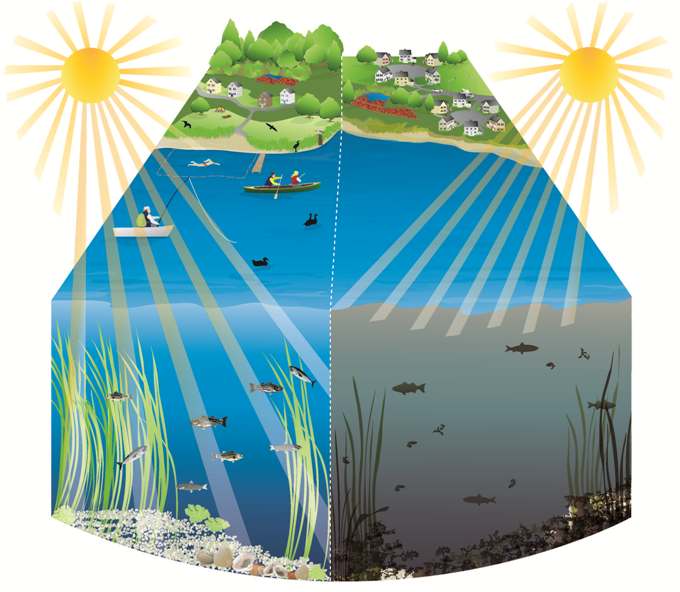A shout out to the Buzzards Bay Coalition for this concise but powerful overview of the damage nitrogen pollution is causing to Cape waterways. Substitute Buzzards Bay with Shoestring Bay and and you’ll understand the looming disaster for our home.
West Falmouth homeowner Bob Kretschmar first noticed it about 10 years ago: slimy green algae creeping along the bottom of West Falmouth Harbor. He could see the algae at low tide, covering the rocky beach where his kids love to swim. Soon, the healthy eelgrass beds that had always grown in the shallow waters by his cottage began to die.
The cause of this algae was nitrogen pollution: the greatest long-term threat to the health of Buzzards Bay. More than half of the Bay’s harbors, coves, and tidal rivers suffer from the effects of nitrogen pollution. We all contribute this harmful pollution to our local waterways – and fortunately, we can all do our part to stop it.
How Does Nitrogen Pollution Harm Buzzards Bay?

In clean water (left), fish and shellfish thrive, and people can enjoy the water. But when the water is polluted with nitrogen (right), it becomes cloudy and murky. Eelgrass can’t grow, and fish and shellfish disappear.
More than half of Buzzards Bay’s harbors, coves, and tidal rivers suffer from nitrogen pollution – from West Falmouth Harbor all the way to the Westport Rivers. Our Bay Health data clearly show the Bay’s decline from nitrogen pollution over the past 25 years.
When water is polluted with nitrogen, it looks cloudy and murky. Algae begins to grow. Eelgrass beds die, and fish and shellfish slowly disappear. In short, nitrogen pollution is quietly destroying the Bay we all love.
In clean water (left), fish and shellfish thrive, and people can enjoy the water. But when the water is polluted with nitrogen (right), it becomes cloudy and murky. Eelgrass can’t grow, and fish and shellfish disappear.
Algae Growth
Nitrogen pollution fuels the growth of algae: tiny plants that can bloom rapidly and fill the water. It’s like adding fertilizer to your garden – except in Buzzards Bay, algae isn’t something we want to grow.
Algae makes the water look cloudy and murky, as if someone stained it brown or green. Lettuce-like clumps form in the shallows and wash up at low tide, fouling our beaches. Along the shoreline, algae form thick, slimy mats of green on rocks, pilings, and tidal flats. Sometimes, algae can even stink like decay.
Loss of Fish and Shellfish
The effects of nitrogen pollution aren’t just ugly to look at. Nitrogen pollution harms the fish and shellfish species that call Buzzards Bay home.
When algae blooms form, they block out sunlight from reaching eelgrass at the bottom. Young fish, crabs, and bay scallops rely on eelgrass as a nursery and safe haven from predators. Without enough sunlight, eelgrass dies. And those species that depend on eelgrass begin to vanish, too.
Algae growth also leads to less oxygen in the water. All of the Bay’s species – from big fish to tiny clams – need oxygen to survive. In places like the Chesapeake Bay and the Gulf of Mexico, severe nitrogen pollution creates large “dead zones” without any oxygen. If nitrogen pollution gets worse, the same thing could happen here in Buzzards Bay.
Where Does Nitrogen Pollution Come From?
Nitrogen pollution is mainly the result of poorly planned development. When new homes are built far away from existing infrastructure, they add more septic systems, manicured lawns, and paved roads to our region.
By far, residential septic systems are the largest single source of nitrogen pollution to Buzzards Bay. Inadequate wastewater treatment is another major source in certain areas. In some waterways, as much as 80% of the nitrogen pollution comes from residential wastewater that isn’t treated as well as it could be.
Septic Systems
Traditional septic systems don’t treat for nitrogen. Instead, nitrogen seeps into groundwater and eventually works its way into coves and harbors, where it can become pollution.
In areas that aren’t connected to sewer plants, homeowners rely on septic systems to treat their wastewater. But most people don’t realize that the typical septic system – even a new, properly functioning Title 5 system – doesn’t remove much nitrogen.
Whether you live near the water or several miles away, your septic system contributes nitrogen pollution to Buzzards Bay. Nitrogen seeps from the leach field into groundwater. From there, nitrogen can travel underground for many miles to the nearest waterway.
In this diagram of a septic system, you can see how nitrogen pollution (in red) seeps into the groundwater and eventually makes its way to the nearest waterway.
Wastewater Treatment Plants
Unlike traditional septic systems, wastewater treatment plants can treat sewage to remove nitrogen. However, they don’t eliminate all the nitrogen – and many municipal plants don’t remove nearly as much as they could. That nitrogen gets emptied into our local waterways, where it becomes pollution.
In certain parts of the Bay, wastewater treatment plants are a large source of nitrogen pollution. For example, the Fairhaven treatment plant has historically discharged to inner New Bedford Harbor, where nitrogen pollution gets trapped inside the hurricane barrier. And at the Marion Wastewater Treatment Plant, 20 acres of unlined sewage lagoons leaked nitrogen directly into the ground for nearly 50 years.
More Sources of Nitrogen Pollution
There are many more sources of nitrogen pollution to Buzzards Bay. They’re small compared to wastewater, but when added together they can have a big impact on the health of our water.
Each time it rains, fertilizer gets washed off lawns and farm fields into local waterways. Cars emit nitrogen oxides into the air, which eventually fall back onto the land as acid rain. Cranberry bogs are another piece of the nitrogen pollution puzzle.

